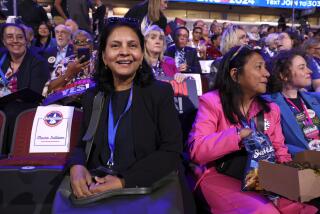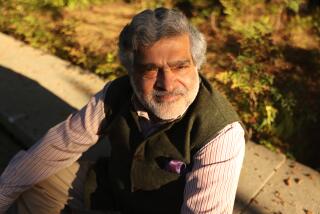Vogue in U.S. : India Public Unaware It’s in Limelight
- Share via
NEW DELHI — Larry Pressler, the Republican senator from South Dakota, was struggling for a way to warm up his audience of mostly Indian journalists at a recent press conference here.
“We are looking for allies in this part of the world,” Pressler said, and as a gesture of American friendship he suggested that the U.S. Army Corps of Engineers be called in to help clean up the polluted Ganges River.
The journalists appeared to be dumbfounded by Pressler’s suggestion. Americans cleaning up the sacred Ganges? The U.S. Army Corps of Engineers?
Undaunted, the senator pressed on.
India has certainly been in the news of late, he said. He mentioned the assassination of Prime Minister Indira Gandhi, the poison gas disaster in Bhopal, the popularity of the film “A Passage to India” and of the television series “The Jewel in the Crown.”
“It is tres chic over at Georgetown University to be talking about India,” Pressler said.
Uncomprehending Stares When he looked out at the journalists, perhaps for some appreciative response, he was greeted by blank, uncomprehending stares. The reporters, educated and mostly middle-class, had not the slightest idea of what he was talking about. India tres chic? Georgetown University?
What had occurred here in the basement of the U.S. Information Service building was the same sort of East-West communications failure that was described so brilliantly in E.M. Forster’s classic 1924 novel, “A Passage to India.”
In Pressler’s case, the Westerner, perhaps misled by the fact that he and his audience spoke a common language, assumed that his audience was aware of the reputation for dependability of the Corps of Engineers.
He also seemed to assume that most Indians are aware of the recent India vogue on American movie and television screens and that they care that major news events have recently put India on the front pages of American newspapers.
U.S. Festival on India
Critically acclaimed films and the forthcoming Festival of India--beginning in June, American museums and universities will sponsor special exhibits and seminars on Indian subjects--have placed India at center stage in the U.S. cultural scene.
However, Indians here are for the most part blissfully unaware of, or at least unimpressed by, this unfamiliar prominence.
“I don’t think people here are basically aware that they are in the limelight,” the cultural affairs officer of a Western diplomatic mission here remarked.
An Indian Foreign Service officer said, “The outside world impacts us less than might be the case in other places. Indians are self-absorbed, much like Americans in that respect. Our newspapers are looking essentially at the country itself. When we look at the outside world it is either with gushing approval or hot-under-the-collar negatives.”
At that moment, a television screen in the corner of the man’s office flashed the news that another Indian batsman had been bowled out in a seemingly interminable cricket match with England, and he blurted, “Bad show!”
If anything has dominated the cultural life of India--in between elections and poison gas incidents--it is this series of cricket “test matches” between India, holder of the World Cup, and England. When the English team arrived in Calcutta, the hotbed of the long movement for independence from Britain, several hundred youths gathered outside the Grand Hotel hoping for a glimpse of the English players.
The cricket matches are the first major sports event to be televised to a large national audience here, and during key periods of play the streets in the large cities are unnaturally quiet.
The involvement with cricket points up the cultural differences between India and the United States. For to the extent that India’s cultural door is open to the West, it is open first to Britain, its colonial ruler for nearly 200 years. British customs and British manners are so ingrained in some parts of the society that they are indistinguishable from the originals. Cricket is one example.
In a way, it is as though the prophesy at the conclusion of “A Passage to India” has come true: “We shall drive every Englishman into the sea,” Dr. Aziz, one of the main characters, is quoted as saying to a Briton. “And then you and I shall be friends.”
Now that the Indians and the British are cozying up, it is the Indians and the Americans who view each other with bewilderment and a little suspicion. For example, the U.S. government is clearly not content with the Indian government’s relationship with the Soviet Union.
“We are very concerned that we are losing India to the Soviets,” Pressler said at his news conference here. A high-ranking Indian official, apprised of the senator’s remarks, commented: “The U.S. is extremely concerned about the Soviet Union in a way we don’t understand.”
Still, there is a feeling, at least in India--and judging by the recent popularity of India in the United States, there as well--that the two countries have much to learn from each other. The late Prime Minister Indira Gandhi was often critical of the United States, but she once boasted that her eldest son, Rajiv, who has succeeded her as prime minister, is a man of action “like an American.”
Indira Gandhi was known to be enthusiastic about the forthcoming $12-million cultural exchange known as the Festival of India. The exchange program and the recent attention India has been getting in the United States, once it becomes known here, could do much to dispel what many Indians feel is an abysmal American ignorance of matters Indian.
Dr. V.K. Narayana Menon, director of the National Academy of Music, Dance and Drama, is a distinguished scholar and was for many years a friend of E.M. Forster. Forster was godfather to one of his daughters. Narayana Menon said recently that when he is in the United States, he notices that the daily newspapers, “apart from two or three, carry very little about India.”
Some of the American ignorance about India may be remedied by the flood of attention now focused on India. For their part, the Indians have more excuse for being largely in the dark about the United States.
India has its own thriving film industry, which is so protected by trade laws that few American movies are shown here. There are only 3 million television sets in India, though there are about 740 million people. The only three American programs shown on Indian television are “I Love Lucy,” “Star Trek” and “Different Strokes.”
“Different Strokes” is a situation comedy about two black children adopted by a rich white New Yorker and his daughter, and figuring out what it tells Indians about the United States could be a lifetime project for an anthropologist.
Indian newspapers carry very little in the way of foreign news, except for news about neighboring Pakistan, Sri Lanka and Bangladesh. Indians with an interest in foreign news generally get it from the British Broadcasting Corp., which has many times more listeners here than the Voice of America.
Foreign reporters traveling outside the major cities are invariably asked if they work for the BBC. They are generally assumed to be British.
To much of the world, Los Angeles is now synonymous with the Olympic Games because of the extensive television coverage of last summer’s Games. However, in India, where television has still to reach many rural areas, it is not unusual to find people who have never heard of Los Angeles, and for whom the United States itself is only a vague concept. More than two-thirds of the Indian population is illiterate.
A Mixed Blessing
Despite all this, India’s sudden prominence in the United States has managed to catch the notice of a few people here. Cover stories in the news magazines Time and Newsweek, which are available at Indian newsstands, have attracted the attention of many Indians and have pleasantly surprised some of them.
Narayana Menon said he was on an Indian Airlines flight between Bombay and New Delhi recently, reading a copy of Time that featured a favorable cover story on Rajiv Gandhi, and he said the man seated next to him observed:
“You know, that is not a bad article. I thought all Americans were anti-Indian and pro-Pakistani, but the overall tone of this story is sympathetic.”
Narayana Menon said he was tempted to ask the man why it was “necessary to have an assassination to find out there were sympathetic Americans.”
For some, however, the newfound attention has been a mixed blessing. For Indian actor Victor Banerjee, who played the role of Dr. Aziz in the film of “A Passage to India,” it has been an annoyance.
Banerjee, a well-known actor who recently completed a critically acclaimed movie for the internationally celebrated Bengali director Satyajit Ray, spoke out sharply on this subject in an interview with the Calcutta Telegraph.
“Now, suddenly I get phone calls from Bombay and Delhi and Los Angeles, all over the place. Los Angeles I can understand, because it’s the first time they have seen me. But India! The ministry in Delhi phones me two nights before they have this party, saying we’ll be greatly privileged if you come across to Delhi and attend the fiasco we’re preparing in the name of the film industry. . . . But this was only after they read Time magazine.”
More to Read
Sign up for Essential California
The most important California stories and recommendations in your inbox every morning.
You may occasionally receive promotional content from the Los Angeles Times.













